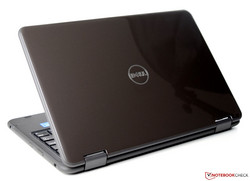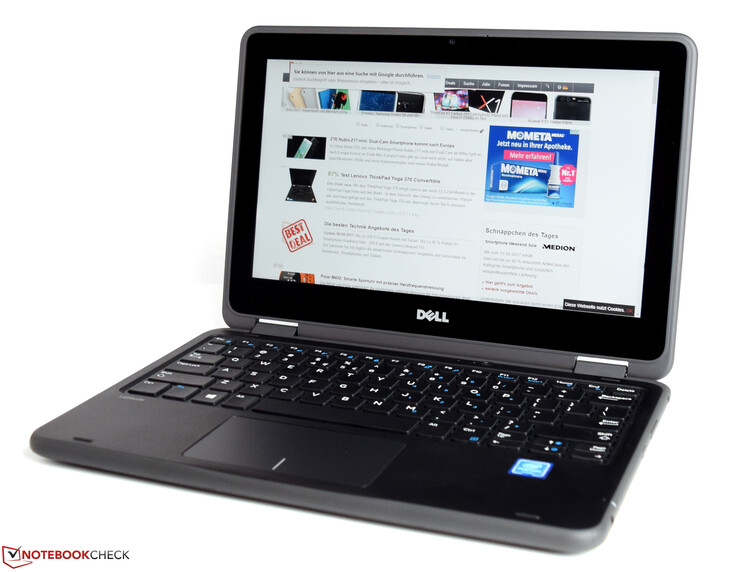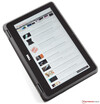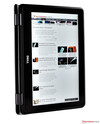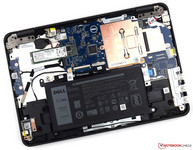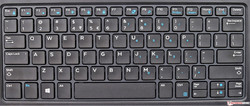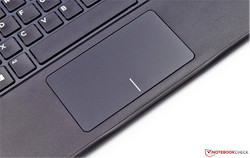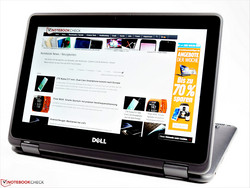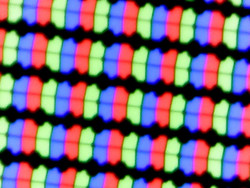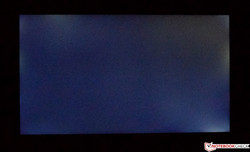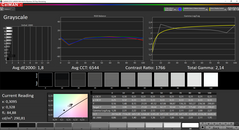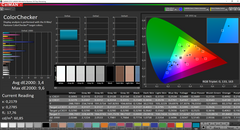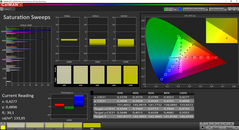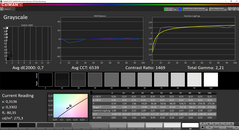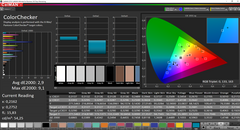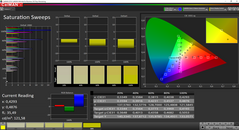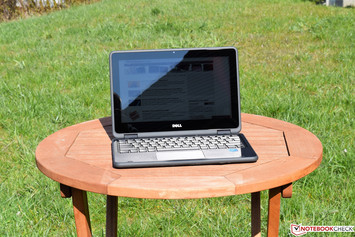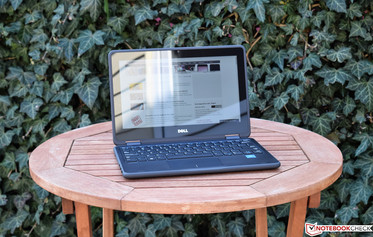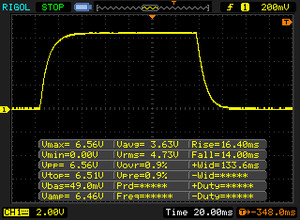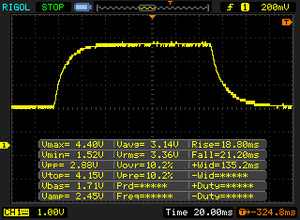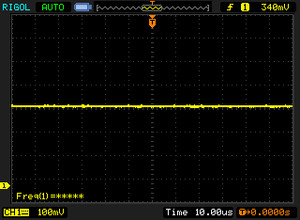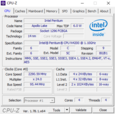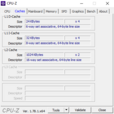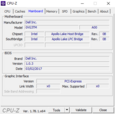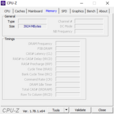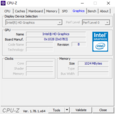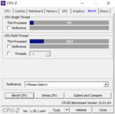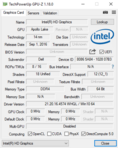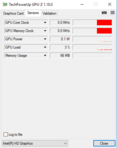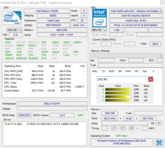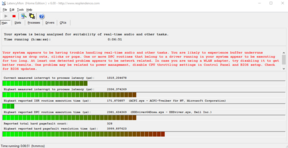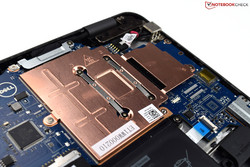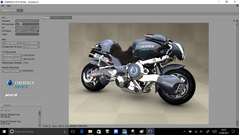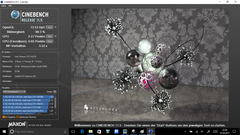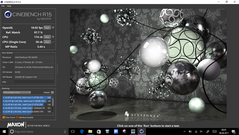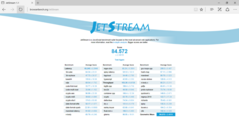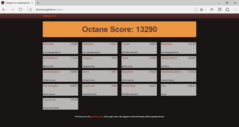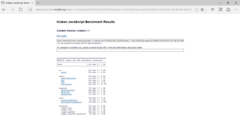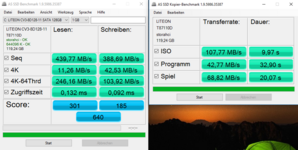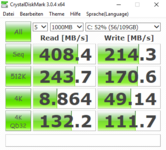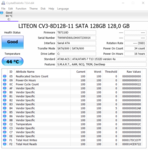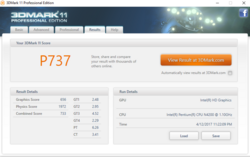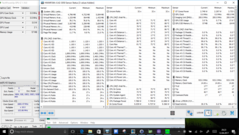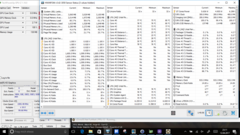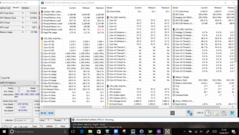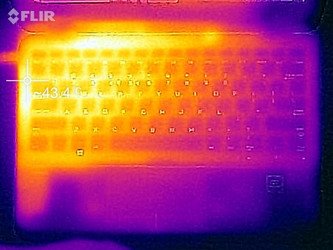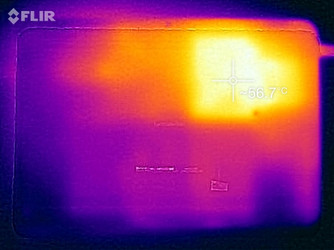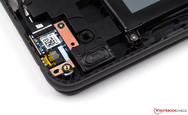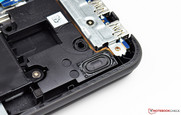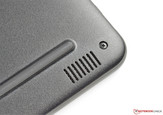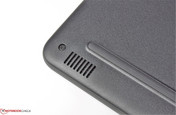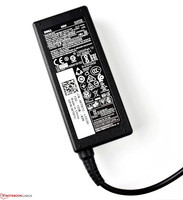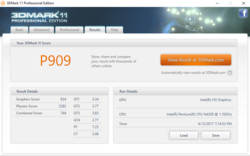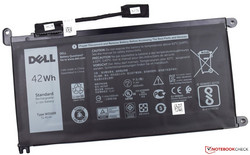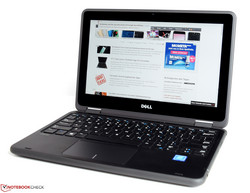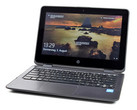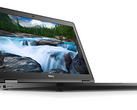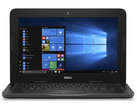Dell Latitude 3189 (N4200, HD) Convertible Review

The Dell Latitude 3189 is also named "Education 2-in-1". This means the convertible is made specifically with education in mind, but it is equally suited for the business sector. This device could be used in training rooms, for example. It is also very suitable for children, because of its robust build that can handle a lot.
However, there is not much leeway for configurations. Basically, the models vary only in the CPU they are equipped with. The cheaper version (770 Euros, ~$839) has an Intel Celeron N3350, while the slightly more expensive model (799 Euros, ~$870) is equipped with an Intel Pentium N4200. Our test unit is equipped with the latter. Additionally, the Dell Latitude 3189 is equipped with 4 GB of DDR3 RAM as well as an SSD with a capacity of 128 GB. The multitouch screen merely has HD resolution, but it is well protected with Corning Gorilla glass.
The comparison devices we have chosen are convertibles with screens between 11 and 13-inches, some of which are equipped with a stronger CPU. You will find out more about how well the Intel Pentium N4200 can compete with them later on. Below, we have listed the comparison devices' most important technical data.
| Medion Akoya P3401T | HP Pavilion 11-k103ng | HP Pavilion x360 13-u102ng | Lenovo Yoga 700-11ISK | Acer Aspire Switch 12 Alpha | |
| CPU | Intel Core m5-6Y54 | Intel Celeron N3050 | Intel Core i5-7200U | Intel Core m3-6Y30 | Intel Core i5-6200U |
| GPU | Intel HD Graphics 515 | Intel HD Graphics (Braswell) | Intel HD Graphics 620 | Intel HD Graphics 515 | Intel HD Graphics 520 |
| Panel | 12.5-inch, 1920x1080 | 11.6-inch, 1366x768 | 13.3-inch, 1920x1080 | 11.6-inch, 1920x1080 | 12-inch, 2160x1440 |
| RAM | 8 GB LPDDR3 | 4 GB DDR3-1600 | 8 GB DDR4-2133 | 4 GB LPDDR3-1866 | 4 GB DDR3L |
| Speicher | 128 GB, SSD | 500 GB, HDD | 1 TB, HDD | 256 GB, SSD | 256 GB, SSD |
Case
The case is made of plastic and has thick rubberized edges that help absorb bumps. The rubber edge surrounds both the base unit and the display cover. This creates a nice design; the gray rubber areas set themselves off against the black case. The display lid is decorated with a tactile Dell logo. The shiny surface looks very nice, but it does not quite fit to the device's intended use, as this surface will scratch easily. There is hardly anything to criticize in terms of stability. The base unit warps under very strong pressure only, which is accompanied by low noises.
The pressure test brought similar results. The surface of the base unit gave way a little above the touchpad. This is due to the device's design; the internal battery placed below that area prevented additional struts being added, which would have meant better stability. The display cover is basically resistant to being warped, as it would only twist lightly under very high pressure. Individual pressure points on the back of the cover caused no waves on the panel. The two 360-degree hinges are strong; you cannot open the device with one hand. Once the display is closed completely, two magnets placed at the bottom of the base unit keep the device closed.
Dell has equipped the Latitude 3189 with a sealed keyboard that keeps the device safe from liquids. But as our test unit is only on loan, we could not test this. Overall, we can say that the Dell Latitude 3189 is very stable and suited to the requirements of lockers and schoolbags.
Size Comparison
The Dell Latitude 3189 has a size of about 30 x 20 cm (~11.8 x 7.8 in) and is quite compact. It is among the smaller models of all the comparison devices. Only the Acer Aspire Switch Alpha and the Lenovo Yoga 700-11ISK are even more compact. In terms of case thickness, the Dell Latitude 3189 appears a little clumpier than its competitors. But that was to be expected, as this robust design requires some space. Its weight of 1.4 kg (~3 lbs) is also not particularly light for an 11-inch device. The Lenovo Yoga 700-11ISK is about 300 g (~0.6 lbs) lighter than our Dell Latitude 3189.
Connectivity
You can see at first glance that the available ports are rather basic. Dell has given the Latitude 3189 only two USB 3.0 ports. Unfortunately, there is no modern USB Type-C port in the Dell Latitude 3189. There is a (full-sized) HDMI connector, so the convertible can also be used as a multimedia device. Beside the usual ports, the Dell Latitude 3189 is also equipped with a card reader on the left side. However, this can read only MicroSD memory cards. If you want to connect traditional SD cards, you will not get around using a USB adaptor.
SD-card reader
As mentioned previously, the Dell Latitude 3189 is equipped with a MicroSD slot only. We tested its performance with our reference card (a Toshiba Exceria Pro M401). Copying jpg files, the slot reaches a data throughput of 61 Mbps which is an average performance. During sequential reading, we noted 83 Mbps, which is quite a decent value. Compared with the Lenovo Yoga 700-11ISK, our test unit has very good values, but it cannot quite beat the HP Pavilion x360. Consequently, the Dell Latitude 3189 is in second place.
| SD Card Reader | |
| average JPG Copy Test (av. of 3 runs) | |
| HP Pavilion x360 13-u102ng | |
| Dell Latitude 3189 | |
| HP Pavilion 11-k103ng x360 | |
| Lenovo Yoga 700-11ISK | |
| maximum AS SSD Seq Read Test (1GB) | |
| HP Pavilion x360 13-u102ng | |
| Dell Latitude 3189 | |
| HP Pavilion 11-k103ng x360 | |
| Lenovo Yoga 700-11ISK | |
Communication
The Intel Dual Band Wireless-AC 7265 module takes care of our wireless network connection. The maximum data transfer rate is 867 Mbit/s. During our test, we reached a good 657 Mbit/s downstream and 548 Mbit/s upstream. Quite a respectable result for the Dell Latitude 3189. This means a lot of data can be transferred without problems. We had no complaints during the entire testing period.
The Dell Latitude 3189 does not offer an Ethernet port. If you do not want to do without a network connection via cable, you will have to resort to a USB adaptor.
| Networking | |
| iperf3 transmit AX12 | |
| Medion Akoya P3401T 2in1 | |
| Dell Latitude 3189 | |
| iperf3 receive AX12 | |
| Dell Latitude 3189 | |
| Medion Akoya P3401T 2in1 | |
Operating System
The Latitude 3189 is only available with Windows 10 Pro (64-bit).
Accessories
Our test unit comes with very few accessories. Apart from the 65-watt power supply, we merely received a quick-start guide and some security information about the device and its components.
The manufacturer offers suitable in-house accessories for its devices. For example, you can additionally purchase one of Dell's various carry cases (36 to 79 Euros, ~$39 to ~$86) online. Dell also offers a suitable storage trolley for 11-inch devices. This might be particularly interesting for training rooms, as it enables safe storage of the devices. It is quite expensive at 3300 Euros (~$3595), but the Dell PC trolley offers space for up to 36 devices that can be charged while stored.
Maintenance
Despite the missing maintenance hatch, it is quite easy to do maintenance work on the Dell Latitude 3189. However, it should not be necessary to do any maintenance for the Dell Latitude 3189 anyway, as it has no active cooling system. The CPU and RAM are not removable or expandable. The SSD - an M.2 2280 module - is the only expandable element.
Warranty
Dell offers a 12-month mail-in warranty for the Latitude 3189. This service can be expanded to a maximum of five years, which would mean an additional one-off payment of 112 Euros (~$122) at purchase. Dell's Support Services are very flexible and vary in duration. Additionally, Dell's service can be combined with ProSupport or ProSupport Plus. That, however, is limited to a length of four years. Please see our Guarantees, Return policies and Warranties FAQ for country-specific information.
Input Devices
Keyboard
The Dell Latitude 3189 is equipped with a chiclet keyboard, which is sealed and protected from water. The keyboard sits in a slight depression on top of the base unit and the white print is nice and clear. The keys are large enough at 15 x 15 millimeters and the surface is slightly rough, similar to the entire surface of the base unit. They are firmly positioned, which avoids too much noise while typing. The keys have medium travel, but the pressure point could be a little firmer. That way, the user would have better feedback, which improves the writing experience. Nonetheless, the keyboard does a perfect job, although we would have wished for a backlit keyboard in order to be able to continue work despite bad lighting. Unfortunately, Dell does not offer backlighting as an optional feature.
Touchpad
The touchpad is 10 x 5.5 cm (~4 x 2.2 in) large and a little narrower than usual due to the lack of space - but that is easy to get used to. The smooth surface of the touchpad stands out from the rough surface of the base unit. The ClickPad itself could have been worked into the base unit a little tighter. As it is, it rattles a little while navigating. It responds well to inputs and there are no problems at the sides or corners. The two clickable areas at the bottom third of the touchpad make a quiet clicking sound when pressed. The ClickPad responds well to gesture control, although the limited space needs a little getting used to.
Touchscreen
The touchscreen is protected from scratches with Corning Gorilla glass, again highlighting its intended use. The manufacturer has decided to go without an input pen, so you can only use your fingers to operate the touchscreen. There are no difficulties while using your finger to navigate; even at the outermost edges the display responded well to our inputs.
(April 25, 2017 update): The Latitude 3189 supports the Active Pen stylus from Dell, which must be purchased separately.
Display
There are no alternatives to the screen. All users who buy the Dell Latitude 3189 have to content themselves with an 11.6-inch IPS screen. The panel offers a native resolution of 1366x768 pixels. The front is protected with Corning Gorilla glass which responds well to touch inputs. Our test unit's average brightness is 284 cd/m². But it has no chance against the Medion Akoya's bright IPS panel at 392 cd/m². In terms of contrast (1819:1) and black level (0.16) on the other hand, the Dell Latitude 3189 does quite a bit better. Contrast and black level create rich, saturated colors without producing a gray film.
The brightness distribution of 92% is quite decent. However, our device suffers from severe backlight-bleeding which can be annoying during dark scenes. We measured no PWM for regulating the display brightness. This is great news, because it avoids additional symptoms of fatigue when the device is used for several hours per day.
| |||||||||||||||||||||||||
Brightness Distribution: 92 %
Center on Battery: 291 cd/m²
Contrast: 1819:1 (Black: 0.16 cd/m²)
ΔE ColorChecker Calman: 3.4 | ∀{0.5-29.43 Ø4.77}
ΔE Greyscale Calman: 1.8 | ∀{0.09-98 Ø5}
67% sRGB (Argyll 1.6.3 3D)
42.8% AdobeRGB 1998 (Argyll 1.6.3 3D)
46.49% AdobeRGB 1998 (Argyll 3D)
67.3% sRGB (Argyll 3D)
44.96% Display P3 (Argyll 3D)
Gamma: 2.14
CCT: 6544 K
| Dell Latitude 3189 IPS, 1366x768, 11.6" | Medion Akoya P3401T 2in1 IPS, 1920x1080, 12.5" | HP Pavilion 11-k103ng x360 IPS, 1366x768, 11.6" | HP Pavilion x360 13-u102ng IPS, 1920x1080, 13.3" | Lenovo Yoga 700-11ISK IPS, 1920x1080, 11.6" | Acer Aspire Switch Alpha 12 SA5-271-56HM IPS, 2160x1440, 12" | |
|---|---|---|---|---|---|---|
| Display | -5% | 1% | -12% | -4% | 44% | |
| Display P3 Coverage (%) | 44.96 | 42.92 -5% | 45.21 1% | 39.43 -12% | 43.6 -3% | 65.5 46% |
| sRGB Coverage (%) | 67.3 | 64.3 -4% | 67.8 1% | 59.1 -12% | 64.2 -5% | 96.1 43% |
| AdobeRGB 1998 Coverage (%) | 46.49 | 44.35 -5% | 46.73 1% | 40.76 -12% | 45.17 -3% | 66.9 44% |
| Response Times | 7% | 39% | 12% | 40% | 19% | |
| Response Time Grey 50% / Grey 80% * (ms) | 40 ? | 40 ? -0% | 18.8 ? 53% | 38 ? 5% | 23 ? 42% | 20 ? 50% |
| Response Time Black / White * (ms) | 30.4 ? | 26 ? 14% | 23.2 ? 24% | 25 ? 18% | 19 ? 37% | 34 ? -12% |
| PWM Frequency (Hz) | 50 ? | 1000 ? | ||||
| Screen | -27% | -13% | -44% | -76% | -47% | |
| Brightness middle (cd/m²) | 291 | 392 35% | 194 -33% | 277 -5% | 300 3% | 345 19% |
| Brightness (cd/m²) | 284 | 392 38% | 186 -35% | 263 -7% | 284 0% | 328 15% |
| Brightness Distribution (%) | 92 | 93 1% | 86 -7% | 88 -4% | 82 -11% | 91 -1% |
| Black Level * (cd/m²) | 0.16 | 0.33 -106% | 0.22 -38% | 0.31 -94% | 0.33 -106% | 0.38 -138% |
| Contrast (:1) | 1819 | 1188 -35% | 882 -52% | 894 -51% | 909 -50% | 908 -50% |
| Colorchecker dE 2000 * | 3.4 | 4.99 -47% | 3.06 10% | 5.57 -64% | 7.87 -131% | 8.4 -147% |
| Colorchecker dE 2000 max. * | 9.6 | 9.08 5% | 8.81 8% | 13.6 -42% | 17.75 -85% | 11.9 -24% |
| Greyscale dE 2000 * | 1.8 | 4.53 -152% | 1.42 21% | 4.56 -153% | 8.45 -369% | 4.3 -139% |
| Gamma | 2.14 103% | 2.46 89% | 2.34 94% | 2.28 96% | 2.42 91% | 2.63 84% |
| CCT | 6544 99% | 7394 88% | 6432 101% | 6648 98% | 6856 95% | 7368 88% |
| Color Space (Percent of AdobeRGB 1998) (%) | 42.8 | 41 -4% | 42.98 0% | 38 -11% | 41 -4% | 62 45% |
| Color Space (Percent of sRGB) (%) | 67 | 64 -4% | 67.56 1% | 59 -12% | 64 -4% | |
| Total Average (Program / Settings) | -8% /
-18% | 9% /
-3% | -15% /
-30% | -13% /
-46% | 5% /
-18% |
* ... smaller is better
Despite some points of criticism, the image quality of the HD panel is quite decent. The colors appear rich thanks to the very good contrast and low black level. While visible in dark scenes, backlight-bleeding shouldn't impact day-to-day work. The average DeltaE 2000 deviations of the grayscales and colors are already quite decent ex-works in comparison to the sRGB reference color space (1.8 and 3.4 respectively). We managed to improve the values even more by calibrating the display. You can download the corresponding ICC profile directly above the comparison table.
The measured color-space coverage (sRGB 67% and Adobe RGB 43%) means that the display is not suitable for professional use.
The display is very reflective and the screen brightness of 284 cd/m² is only average. This is very limiting when you want to use the device outdoors. In the sun, the screen is not bright enough to be able to work comfortably. Even in the shade, the reflections are annoying after a while. If you cannot avoid using the device outside, we would recommend finding a spot in the shade.
Display Response Times
| ↔ Response Time Black to White | ||
|---|---|---|
| 30.4 ms ... rise ↗ and fall ↘ combined | ↗ 16.4 ms rise | |
| ↘ 14 ms fall | ||
| The screen shows slow response rates in our tests and will be unsatisfactory for gamers. In comparison, all tested devices range from 0.1 (minimum) to 240 (maximum) ms. » 82 % of all devices are better. This means that the measured response time is worse than the average of all tested devices (20.2 ms). | ||
| ↔ Response Time 50% Grey to 80% Grey | ||
| 40 ms ... rise ↗ and fall ↘ combined | ↗ 18.8 ms rise | |
| ↘ 21.2 ms fall | ||
| The screen shows slow response rates in our tests and will be unsatisfactory for gamers. In comparison, all tested devices range from 0.165 (minimum) to 636 (maximum) ms. » 60 % of all devices are better. This means that the measured response time is worse than the average of all tested devices (31.6 ms). | ||
Screen Flickering / PWM (Pulse-Width Modulation)
| Screen flickering / PWM not detected | |||
In comparison: 53 % of all tested devices do not use PWM to dim the display. If PWM was detected, an average of 8086 (minimum: 5 - maximum: 343500) Hz was measured. | |||
The viewing-angle stability is good, which is the great advantage of IPS panels. The screen has great viewing angles and our test image can be seen well from all nine angles. You can see a light veil over the two corner images, but this is hardly noticeable, as it appears only at a very wide, almost flat angle.
Performance

Our test unit is equipped with an Intel Pentium N4200 which has 4GB of DDR3 RAM available. It also features a 128 GB SSD storage device, from which the system benefits highly. The alternative configuration of the Dell Latitude 3189 contains an Intel Celeron N3350. However, this has two physical cores only, while the Intel Pentium N4200 has a native quad-core CPU. Despite our test unit being fitted with a faster CPU, the DPC Latencies are elevated. However, we did not encounter any problems due to these elevated DPC Latencies during the entire testing period.
Processor
Our test unit is equipped with the Intel Pentium N4200. This quad-core SoC is primarily used for low-priced notebooks and clocks between 1.1 and 2.5 GHz. The processor belongs to the Apollo Lake generation and is firmly soldered into the device. Its performance depends highly on the cooling system. The competitors did a lot better in our benchmarks. The Intel Pentium N4200 has no chance against the HP Pavilion x360 or the Acer Aspire Switch Alpha. Only in the Cinebench R15 Multi benchmark did our Dell Latitude 3189 manage to do better than the Lenovo Yoga 700-11ISK. On the other hand, the Intel Core m3-6Y30's single-core performance was 42% higher than that of the Intel Pentium N4200.
After reaching the TDP limit of 6 watts, the performance drops slighly. Then, the results of the Cinebench R15 multi-loop test even out and seem relatively steady.
You can find further benchmarks for the Intel Pentium N4200 here.
| Cinebench R11.5 | |
| CPU Single 64Bit | |
| HP Pavilion x360 13-u102ng | |
| Dell Latitude 3189 | |
| CPU Multi 64Bit | |
| HP Pavilion x360 13-u102ng | |
| Dell Latitude 3189 | |
| JetStream 1.1 - Total Score | |
| HP Pavilion x360 13-u102ng | |
| Medion Akoya P3401T 2in1 | |
| Acer Aspire Switch Alpha 12 SA5-271-56HM | |
| Lenovo Yoga 700-11ISK | |
| Dell Latitude 3189 | |
| HP Pavilion 11-k103ng x360 | |
| Octane V2 - Total Score | |
| HP Pavilion x360 13-u102ng | |
| Acer Aspire Switch Alpha 12 SA5-271-56HM | |
| Lenovo Yoga 700-11ISK | |
| Dell Latitude 3189 | |
| Mozilla Kraken 1.1 - Total | |
| Dell Latitude 3189 | |
| Lenovo Yoga 700-11ISK | |
| Acer Aspire Switch Alpha 12 SA5-271-56HM | |
| HP Pavilion x360 13-u102ng | |
* ... smaller is better
System Performance
Because of the rather weak CPU in the Dell Latitude 3189, the results from PCMark 8 are quite low. It came last in many of the tests. The devices equipped with the faster Intel Core i5 are in a league of their own, which our test device will never reach. However, do not take these test results too seriously - subjectively, the system performance is good anyway. Thanks to the fitted SSD, the system is ready to go quickly and lets you work at a comfortable speed throughout the day. The Dell Latitude 3189's performance is definitely sufficient for its intended use, even if future programs might cause it to need a little longer to load.
| PCMark 8 | |
| Home Score Accelerated v2 | |
| Acer Aspire Switch Alpha 12 SA5-271-56HM | |
| HP Pavilion x360 13-u102ng | |
| Medion Akoya P3401T 2in1 | |
| Lenovo Yoga 700-11ISK | |
| Dell Latitude 3189 | |
| HP Pavilion 11-k103ng x360 | |
| Work Score Accelerated v2 | |
| HP Pavilion x360 13-u102ng | |
| Acer Aspire Switch Alpha 12 SA5-271-56HM | |
| Lenovo Yoga 700-11ISK | |
| Dell Latitude 3189 | |
| Creative Score Accelerated v2 | |
| HP Pavilion x360 13-u102ng | |
| Lenovo Yoga 700-11ISK | |
| Dell Latitude 3189 | |
| PCMark 7 | |
| Score | |
| Dell Latitude 3189 | |
| HP Pavilion x360 13-u102ng | |
| Productivity | |
| Dell Latitude 3189 | |
| HP Pavilion x360 13-u102ng | |
| PCMark Vantage Result | 9360 points | |
| PCMark 7 Score | 4259 points | |
| PCMark 8 Home Score Accelerated v2 | 2273 points | |
| PCMark 8 Creative Score Accelerated v2 | 2585 points | |
| PCMark 8 Work Score Accelerated v2 | 2993 points | |
Help | ||
Storage Devices
As already mentioned several times, our test unit is equipped with an SSD with 128 GB of storage capacity. To be clear, we would have preferred an SSD with 256 GB, as the Windows operating system takes up so much space that in the end, the user only has 95 GB available. The SSD with the form factor M.2 2280 from Lite-On reaches 439 Mbps and 388 Mbps (sequential reading and writing respectively), which are quite reasonable values. The Dell Latitude 3189 can outdo the devices furnished with conventional hard drives.
| Dell Latitude 3189 Liteonit CV3-8D128 | Medion Akoya P3401T 2in1 | HP Pavilion 11-k103ng x360 Hitachi Travelstar Z5K500 HTS545050A7E680 | HP Pavilion x360 13-u102ng HGST Travelstar 5K1000 HTS541010A7E630 | Lenovo Yoga 700-11ISK Samsung SSD PM871 MZNLN256HCHP | Acer Aspire Switch Alpha 12 SA5-271-56HM Kingston RBU-SNS8152S3256GG2 | |
|---|---|---|---|---|---|---|
| CrystalDiskMark 3.0 | 37% | -85% | -87% | 97% | 70% | |
| Read Seq (MB/s) | 408.4 | 427.6 5% | 106 -74% | 104.8 -74% | 456.2 12% | 518 27% |
| Write Seq (MB/s) | 214.3 | 286.5 34% | 106.1 -50% | 91 -58% | 302.8 41% | 199.9 -7% |
| Read 512 (MB/s) | 243.7 | 324.1 33% | 33.53 -86% | 20.67 -92% | 385.7 58% | 374.9 54% |
| Write 512 (MB/s) | 170.6 | 121.8 -29% | 39.03 -77% | 45.05 -74% | 301.9 77% | 201 18% |
| Read 4k (MB/s) | 8.864 | 28.11 217% | 0.407 -95% | 0.215 -98% | 31.27 253% | 29.3 231% |
| Write 4k (MB/s) | 49.14 | 41.68 -15% | 1.026 -98% | 1.037 -98% | 73.6 50% | 76.8 56% |
| Read 4k QD32 (MB/s) | 132.2 | 249.2 89% | 0.898 -99% | 0.968 -99% | 324.2 145% | 272 106% |
| Write 4k QD32 (MB/s) | 111.7 | 68.8 -38% | 1.003 -99% | 1.09 -99% | 268.6 140% | 197.1 76% |
Graphics
The integrated GPU, Intel HD Graphics 505, is responsible for image output and was presented together with the Apollo Lake generation in mid-2016. The graphics unit convinced us with its low power consumption. At maximum expansion level, the Intel HD Graphics 505 has 18 Execution Units (EUs) available that work at a maximum of 750 MHz. The graphics unit is based on the Intel Gen9 architecture, which is also used for the significantly more expensive Skylake series. Nonetheless, the performance of the Intel HD Graphics 505 suffices only for the low-end segment. Consequently, the benchmark results are rather low. Our test unit cannot beat the Lenovo Yoga 700-11ISK.
You can find further benchmarks for the Intel HD Graphics 505 here.
| 3DMark | |
| 1280x720 Cloud Gate Standard Graphics | |
| Acer Aspire Switch Alpha 12 SA5-271-56HM | |
| HP Pavilion x360 13-u102ng | |
| Dell Latitude 3189 | |
| Lenovo Yoga 700-11ISK | |
| 1920x1080 Fire Strike Graphics | |
| HP Pavilion x360 13-u102ng | |
| Dell Latitude 3189 | |
| Lenovo Yoga 700-11ISK | |
| 3DMark 11 - 1280x720 Performance GPU | |
| Acer Aspire Switch Alpha 12 SA5-271-56HM | |
| HP Pavilion x360 13-u102ng | |
| Medion Akoya P3401T 2in1 | |
| Lenovo Yoga 700-11ISK | |
| Dell Latitude 3189 | |
| HP Pavilion 11-k103ng x360 | |
| 3DMark 11 Performance | 883 points | |
| 3DMark Ice Storm Standard Score | 33896 points | |
| 3DMark Cloud Gate Standard Score | 3558 points | |
| 3DMark Fire Strike Score | 565 points | |
| 3DMark Fire Strike Extreme Score | 260 points | |
| 3DMark Time Spy Score | 118 points | |
Help | ||
Gaming Performance
The Dell Latitude 3189 is first and foremost designed to be a work tool. The performance of the fitted graphics unit Intel HD Graphics 505 is not sufficient for a smooth display of video games. If you need a higher 3D performance, we would recommend finding a device with a dedicated GPU.
| low | med. | high | ultra | |
|---|---|---|---|---|
| BioShock Infinite (2013) | 30.6 | 17.3 | 15.1 | |
| Battlefield 4 (2013) | 20.9 | 15.2 | 9.5 | |
| Rise of the Tomb Raider (2016) | 6.1 | 4 |
Emissions
System Noise
There is very low system noise due to the device's passive cooling. The Dell Latitude 3189 carries out its work almost silently. During operation, you can hear the occasional electronic sound, but it is a lot quieter than an active cooling fan would be. From our comparison devices only the HP Pavilion x360 is cooled actively, which explains why you will only find a value for that device in the comparison chart below.
| Dell Latitude 3189 Pentium N4200, HD Graphics 505 | Medion Akoya P3401T 2in1 6Y54, HD Graphics 515 | HP Pavilion 11-k103ng x360 N3050, HD Graphics (Braswell) | HP Pavilion x360 13-u102ng i5-7200U, HD Graphics 620 | Lenovo Yoga 700-11ISK 6Y30, HD Graphics 515 | Acer Aspire Switch Alpha 12 SA5-271-56HM 6200U, HD Graphics 520 | |
|---|---|---|---|---|---|---|
| Emissions | ||||||
| Fan Noise (dB(A)) | 37.3 |
Temperature
The passive cooling system has advantages and disadvantages. We already wrote about its advantages in the section about system noise. But the heat that is created can cause high case temperatures when the device is working under load - simply because the heat has nowhere else to go. The hotspot at the bottom of the base unit is around the CPU and heats up to almost 55 °C (~131 °F). This can mean that having the device on your lap can be uncomfortable when it has worked under load for a while.
We measured the highest CPU temperature during our stress test, in which we run the program Prime95 for at least an hour. After an initial 2.4 GHz, the CPU settles at a stable 1.8 GHz after a while. The processor reached a maximum temperature of 88 °C (~190 °F). A little higher and the device would have reached the limit for thermal throttling, but this security feature did not have to come to the rescue of the CPU during our test.
Directly afterwards, we measured the 3D performance again with the 3DMark 11 test. The results were a little lower after the stress test in comparison to the cold start.
(±) The maximum temperature on the upper side is 43.3 °C / 110 F, compared to the average of 35.4 °C / 96 F, ranging from 19.6 to 60 °C for the class Convertible.
(-) The bottom heats up to a maximum of 54.9 °C / 131 F, compared to the average of 36.8 °C / 98 F
(+) In idle usage, the average temperature for the upper side is 26 °C / 79 F, compared to the device average of 30.3 °C / 87 F.
(±) The palmrests and touchpad can get very hot to the touch with a maximum of 37.9 °C / 100.2 F.
(-) The average temperature of the palmrest area of similar devices was 27.9 °C / 82.2 F (-10 °C / -18 F).
| Dell Latitude 3189 Pentium N4200, HD Graphics 505 | Medion Akoya P3401T 2in1 6Y54, HD Graphics 515 | HP Pavilion 11-k103ng x360 N3050, HD Graphics (Braswell) | HP Pavilion x360 13-u102ng i5-7200U, HD Graphics 620 | Lenovo Yoga 700-11ISK 6Y30, HD Graphics 515 | Acer Aspire Switch Alpha 12 SA5-271-56HM 6200U, HD Graphics 520 | |
|---|---|---|---|---|---|---|
| Heat | 12% | -17% | 15% | -1% | -3% | |
| Maximum Upper Side * (°C) | 43.3 | 38.1 12% | 44.6 -3% | 34.6 20% | 36.8 15% | 46.7 -8% |
| Maximum Bottom * (°C) | 54.9 | 41.7 24% | 53.1 3% | 36.4 34% | 42 23% | 51 7% |
| Idle Upper Side * (°C) | 27.5 | 27.9 -1% | 35.2 -28% | 26.6 3% | 32.1 -17% | 29.5 -7% |
| Idle Bottom * (°C) | 27.9 | 24.1 14% | 38.6 -38% | 27.7 1% | 34.4 -23% | 28.6 -3% |
* ... smaller is better
Speakers
The two speakers are positioned toward the front of the base unit, below the wrist rest. The sound is directed out of the case via the bottom of the base, which means the sound is muted when lying on a soft support. Because of how compact it is, you can hear mainly mid and high-range frequencies. The bass is swallowed almost completely. The small speakers reach a maximum of 83 dB(A). The small speakers easily suffice for watching YouTube videos. But if sound quality is important to you, you will not get around using an external sound system. The 3.5 mm audio jack provided works very well.
Dell Latitude 3189 audio analysis
(+) | speakers can play relatively loud (83 dB)
Bass 100 - 315 Hz
(-) | nearly no bass - on average 23.3% lower than median
(±) | linearity of bass is average (8.3% delta to prev. frequency)
Mids 400 - 2000 Hz
(±) | reduced mids - on average 5% lower than median
(±) | linearity of mids is average (8.1% delta to prev. frequency)
Highs 2 - 16 kHz
(+) | balanced highs - only 4.5% away from median
(+) | highs are linear (6.5% delta to prev. frequency)
Overall 100 - 16.000 Hz
(±) | linearity of overall sound is average (19.2% difference to median)
Compared to same class
» 45% of all tested devices in this class were better, 7% similar, 48% worse
» The best had a delta of 6%, average was 20%, worst was 57%
Compared to all devices tested
» 45% of all tested devices were better, 7% similar, 47% worse
» The best had a delta of 4%, average was 24%, worst was 134%
Apple MacBook 12 (Early 2016) 1.1 GHz audio analysis
(+) | speakers can play relatively loud (83.6 dB)
Bass 100 - 315 Hz
(±) | reduced bass - on average 11.3% lower than median
(±) | linearity of bass is average (14.2% delta to prev. frequency)
Mids 400 - 2000 Hz
(+) | balanced mids - only 2.4% away from median
(+) | mids are linear (5.5% delta to prev. frequency)
Highs 2 - 16 kHz
(+) | balanced highs - only 2% away from median
(+) | highs are linear (4.5% delta to prev. frequency)
Overall 100 - 16.000 Hz
(+) | overall sound is linear (10.2% difference to median)
Compared to same class
» 7% of all tested devices in this class were better, 2% similar, 91% worse
» The best had a delta of 5%, average was 18%, worst was 53%
Compared to all devices tested
» 4% of all tested devices were better, 1% similar, 94% worse
» The best had a delta of 4%, average was 24%, worst was 134%
Frequency diagram in comparison (checkboxes above can be turned on/off)
Energy Management
Power Consumption
The Dell Latitude 3189 consumes very little power. The efficient processor and other components have very low power consumption. While idling, our test device consumes only 2 to 6 watts. This is a very good result - many other comparison devices need a considerably higher amount. The consumption goes up to an average of 16 watts under load, which is still a good result, although in this situation the HP Pavilion consumes slightly less. At peak consumption, we measured 24 watts for our Dell Latitude. In standby mode, our test unit needs only 0.27 watts. Some of the comparison devices eat up quite a lot more.
The power supply of the Dell Latitude 3189 provides a maximum of 65 watts which is perfectly adequate for this device.
| Off / Standby | |
| Idle | |
| Load |
|
Key:
min: | |
| Dell Latitude 3189 Pentium N4200, HD Graphics 505, Liteonit CV3-8D128, IPS, 1366x768, 11.6" | Medion Akoya P3401T 2in1 6Y54, HD Graphics 515, , IPS, 1920x1080, 12.5" | HP Pavilion 11-k103ng x360 N3050, HD Graphics (Braswell), Hitachi Travelstar Z5K500 HTS545050A7E680, IPS, 1366x768, 11.6" | HP Pavilion x360 13-u102ng i5-7200U, HD Graphics 620, HGST Travelstar 5K1000 HTS541010A7E630, IPS, 1920x1080, 13.3" | Lenovo Yoga 700-11ISK 6Y30, HD Graphics 515, Samsung SSD PM871 MZNLN256HCHP, IPS, 1920x1080, 11.6" | Acer Aspire Switch Alpha 12 SA5-271-56HM 6200U, HD Graphics 520, Kingston RBU-SNS8152S3256GG2, IPS, 2160x1440, 12" | |
|---|---|---|---|---|---|---|
| Power Consumption | -37% | -45% | -66% | -29% | -105% | |
| Idle Minimum * (Watt) | 2.17 | 3.8 -75% | 5.3 -144% | 4.7 -117% | 4.3 -98% | 7.3 -236% |
| Idle Average * (Watt) | 4.31 | 7.1 -65% | 7.1 -65% | 7.2 -67% | 7.1 -65% | 10 -132% |
| Idle Maximum * (Watt) | 5.79 | 8.1 -40% | 8.2 -42% | 7.9 -36% | 7.2 -24% | 10.15 -75% |
| Load Average * (Watt) | 15.8 | 19.1 -21% | 15.5 2% | 30 -90% | 14.6 8% | 25.2 -59% |
| Load Maximum * (Watt) | 24.2 | 20.2 17% | 18.9 22% | 29 -20% | 15.7 35% | 29.3 -21% |
* ... smaller is better
Battery Runtime
Dell has chosen a non-removable 42 Wh lithium-ion battery for the Latitude 3189. The very low power consumption contributes highly to the long battery runtime of our test unit. Without load, the device lasts about 22 hours before it needs to be reconnected to the power supply. Even under load the battery lasts a good 4 hours thanks to the energy-efficient processor.
Our Wi-Fi test is a lot more practically oriented. It opens different websites every 30 seconds. For this test, the energy profile is set to “balanced” and the display brightness is set to about 150 cd/m². In the case of the Dell Latitude 3189, that meant lowering the brightness by five levels. At this setting, one battery charge lasts a little over 10 hours. The Dell Latitude 3189 has also mastered playing videos, only needing to be recharged after 8:21 hours. It takes about 2:24 hours to charge the notebook. Here, the Dell outperforms all of its competitors. However, we should take into account that many of the comparison devices are a lot more powerful as well.
We measured no reduction in 3D performance on battery power.
| Dell Latitude 3189 Pentium N4200, HD Graphics 505, 42 Wh | Medion Akoya P3401T 2in1 6Y54, HD Graphics 515, 51 Wh | HP Pavilion 11-k103ng x360 N3050, HD Graphics (Braswell), 32 Wh | HP Pavilion x360 13-u102ng i5-7200U, HD Graphics 620, 41 Wh | Lenovo Yoga 700-11ISK 6Y30, HD Graphics 515, 40 Wh | Acer Aspire Switch Alpha 12 SA5-271-56HM 6200U, HD Graphics 520, 37 Wh | |
|---|---|---|---|---|---|---|
| Battery runtime | -28% | -52% | -52% | -21% | -40% | |
| Reader / Idle (h) | 22 | 9.3 -58% | 14.4 -35% | 10.7 -51% | ||
| H.264 (h) | 8.4 | 5.3 -37% | 7.7 -8% | 7.8 -7% | ||
| WiFi v1.3 (h) | 10.1 | 7.3 -28% | 4.8 -52% | 5.4 -47% | 7 -31% | 5.4 -47% |
| Load (h) | 4.2 | 1.4 -67% | 3.8 -10% | 1.9 -55% |
Verdict
Pros
Cons
Dell has aimed the Latitude 3189 mainly at the education sector. The basis for this has been established with its robust design. Additional features such as a touchscreen are good and add additional value to the device. This also makes the device a lot more versatile. The Intel Pentium N4200, which can rely on 4 GB of DDR3 RAM, is the maximum of what the manufacturer has to offer concerning performance. We would not recommend the alternative CPU configuration with the Intel Celeron N3350. Our test unit, which is not the cheapest at 799 Euros (~$870), runs quite well, but with an Intel Celeron N3350 (dual-core processor), the performance would be significantly worse.
The Dell Latitude 3189 is a very robust device, which helps children learn how to handle the new media. The stable base unit can handle quite a lot and thanks to its great battery runtime, one battery charge easily lasts an entire day at school.
We have got a few things to criticize about the Dell Latitude 3189: for example, the missing USB Type-C port, which would secure the device's future, and the very reflective display, which can be irritating and makes it difficult to work in light spaces. The storage device has advantages and disadvantages. Once the operating system and some programs are installed, not much is left of the 128 GB storage capacity. Overall, we can say that despite it not doing so well in some areas compared with the other test units, the Dell Latitude 3189 does a solid job. The subjective system performance was definitely better than the results the benchmarks showed.
Dell Latitude 3189
- 04/25/2017 v6 (old)
Sebastian Bade


